Take 5
Bijin-ga: Beauties of the Floating World
During the Edo period (1603-1868), a peaceful and prosperous time for Japan, a strong and active print culture was creating woodblock prints known as ukiyo-e. During the medieval period (1185-1573) the term ukiyo meant ‘a condition of impermanence created by daily life and its desires’. Taken alone, uki translates to ‘suffering’ while yo means ‘world’ and e (pronounced “eh”) means ‘picture’. At the turn of the 17th century the meaning of uki changed, translating instead to ‘floating’, and ukiyo-e then became known as ‘pictures of the floating world’. This change in language glorified life’s transient pleasures: those of fleeting feelings and the lust of parties, fashion and elicit passions. Ukiyo-e were used to promote the latest fashions for both men and women, as well as a marketing tool for courtesans and their brothels. The woodblock prints spotlit celebrities including kabuki actors, courtesans and geishas, and over time subject matter broadened to encompass depictions of landscapes and nature. One of the most popular subjects was ‘beautiful people’ or in Japanese bijin-ga, which depicted both men and women.
Kitagawa Utamaro was universally considered the foremost artist for depictions of bijin-ga. His woodblock prints enforced a stereotype of beauty and an idealised image of women with a large head, long slender neck, and small shoulders and hands. He rose to prominence in the early 1790s and took the hari (‘dash and independent spirit’) and iki (‘chic sex appeal’) established by his predecessors to a new level. This is exemplified in Utamaro’s Woman reading a letter (Fumi yomu onna) from the series Ten classes of women’s physiognomy, where the artist attempts to reveal different emotions and facets of highly desirable women. Typical bijin-ga portraits do not depict the subject’s individual personality. Instead the women are seemingly caught in action, in a moment of thought and unaware they are being watched and objectified. Despite these stereotypical depictions, the high-ranking courtesans and public figures represented in works such as these were educated, highly intellectual and witty women.
Flinders University Museum of Art boasts a small collection of bijin-ga woodblock prints by Utamaro Kitagawa and many of his contemporaries. The five works presented here were generously donated to FUMA by avid collector Miss Marion Elizabeth Wharmby. Over a twenty-year period from 1971 until her death in 1991, Miss Wharmby bequeathed her print collection to Flinders University. Totalling over 600 works on paper, the Wharmby collection features works from across the globe including works by indigenous artists from Australia, Papua New Guinea, North America and Africa, Japanese ukiyo-e woodblock prints, British and European masters and examples of colonial and 20th century Australian art.
Flinders University students and staff can explore Miss Marion Elizabeth Wharmby’s bequest via Flinders University Museum of Art’s Online Collections Catalogue.
Madeline Reece
Exhibition and Public Programs Manager (Acting), Flinders University Museum of Art
Adelaide, Australia, 2020
© Flinders University Museum of Art
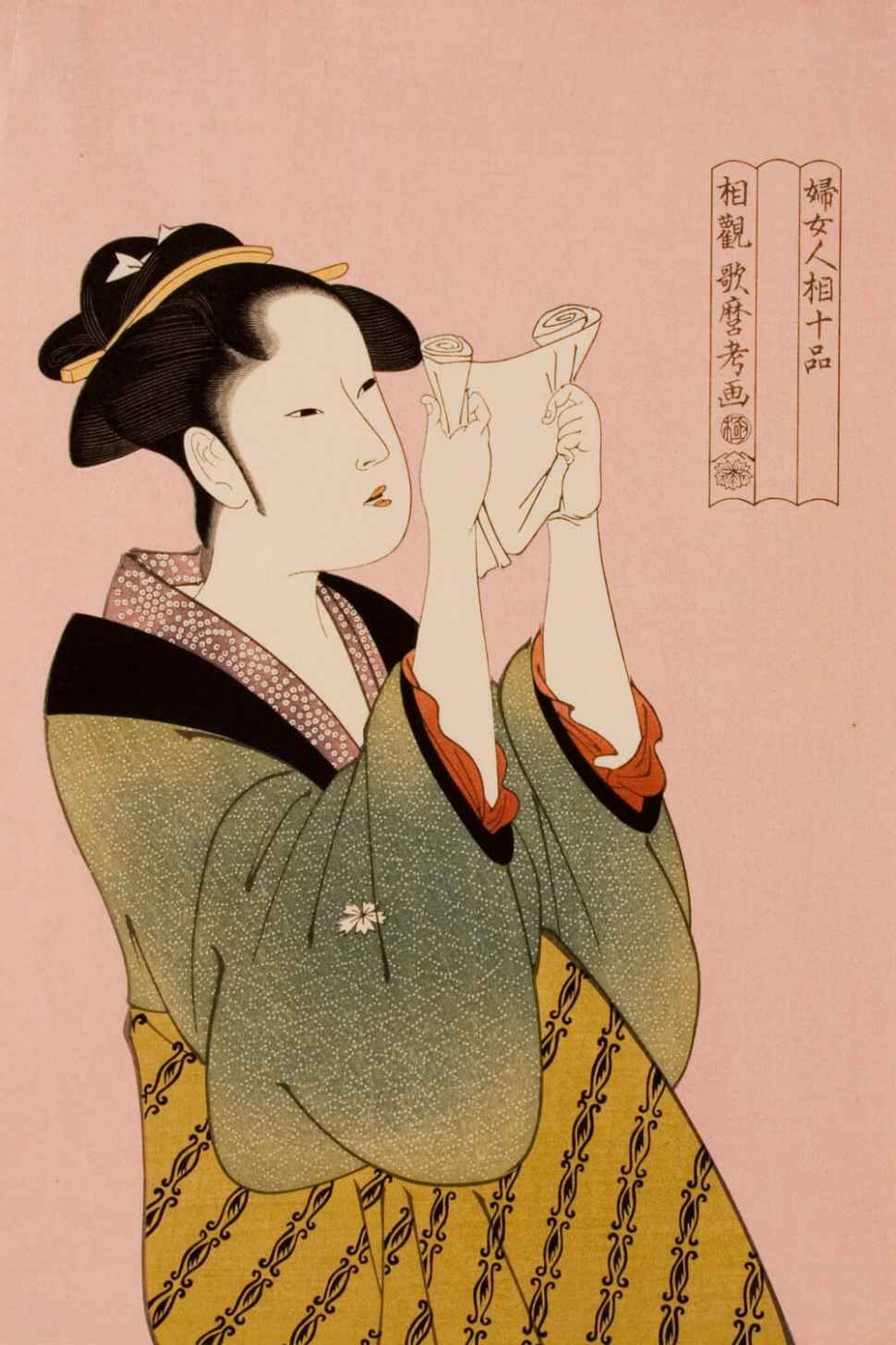
Kitagawa Utamaro
Born 1753
Died 1806
Woman reading a letter (Fumi yomu onna) From the series Ten classes of women’s physiognomy (Fujo ninso Juppon) c.1772
woodblock print, coloured inks and white mica on paper 39 x 26.7 cm
Gift of Miss M.E. Wharmby
Collection of Flinders University Museum of Art 445
Although we do not know the identity of the sitter in this work visual cues within the portrait help us obtain some information about her life. We know she is married, indicated by her shaved eyebrows and black teeth. She may be the wife of a restaurant or shop owner, signified by the small floral embellishment on her sleeve which is a mon (family crest).
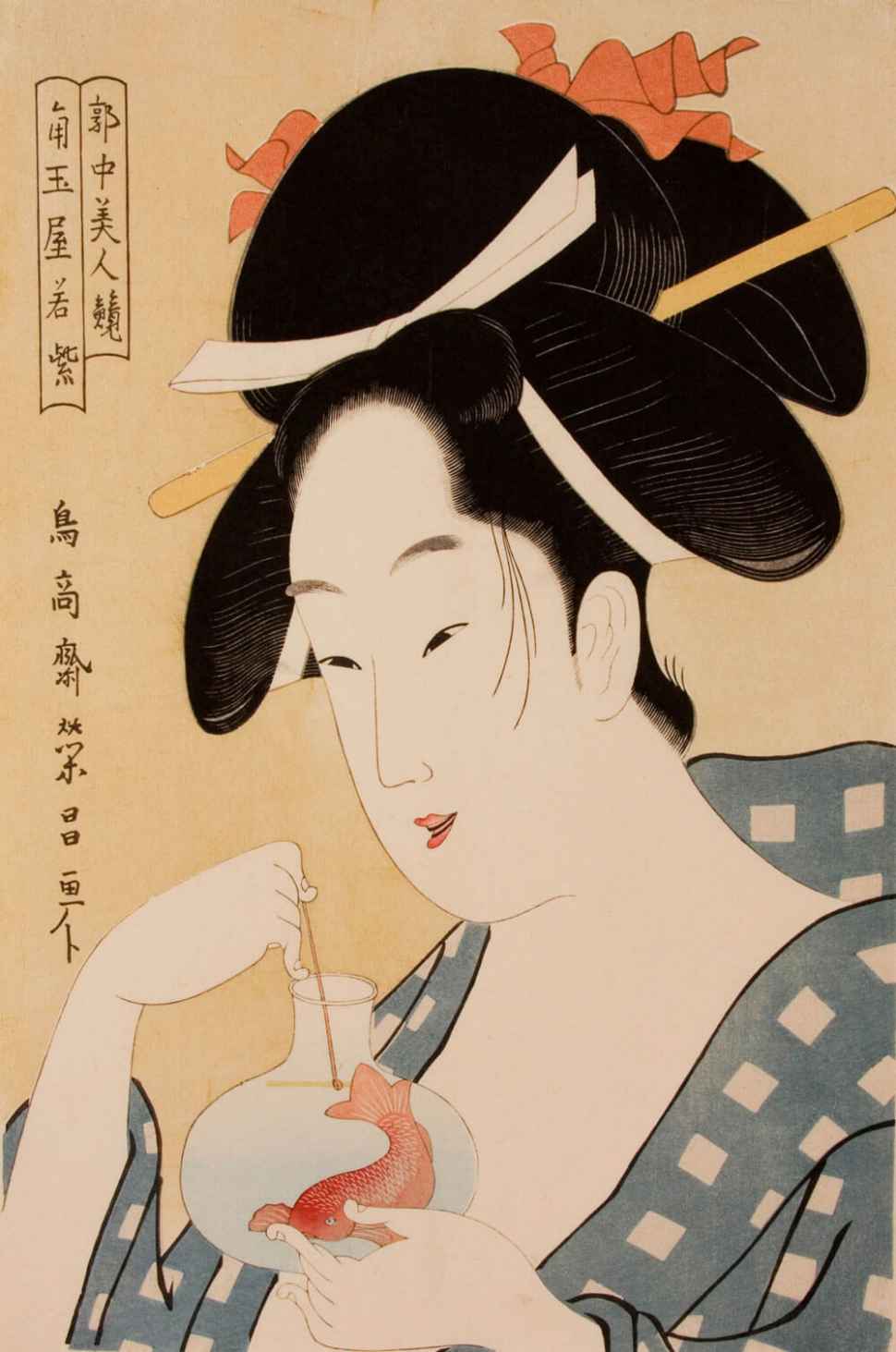
Chokosai Eisho
Active 1780-1800
Wakamurasaki from the Kado Tamaya establishment from the series Comparisons of beauties of the pleasure district (Kakuchu bijin kurabe) c.1795 woodblock print, coloured inks on paper 37.7 x 25 cm
Gift of Miss M.E. Wharmby
Collection of Flinders University Museum of Art 446
Chokosai Eisho, or Shoeido, was an ukiyo-e artist active at the end of the 18th century (1780-1800). He was a pupil of Chobunsai Eishi (1756-1829) but his bijin-ga portraits suggest a strong stylistic influence of Kitagawa Utamaro, particularly in Wakamurasaki from the Kado Tamaya establishment from the series Comparisons of beauties of the pleasure district (Kakuchu bijin kurabe)(i). Here Eisho captures a high-ranking courtesan from Kado Tamaya (Tamaya on the corner), a brothel house in Edo run by Tamaya Sansaburo (ii). The cropped composition and voyeuristic perspective echo Utamaro’s Bijin okubi-e (Large-headed pictures of beautiful women) of the Kansei period (1789-1801).
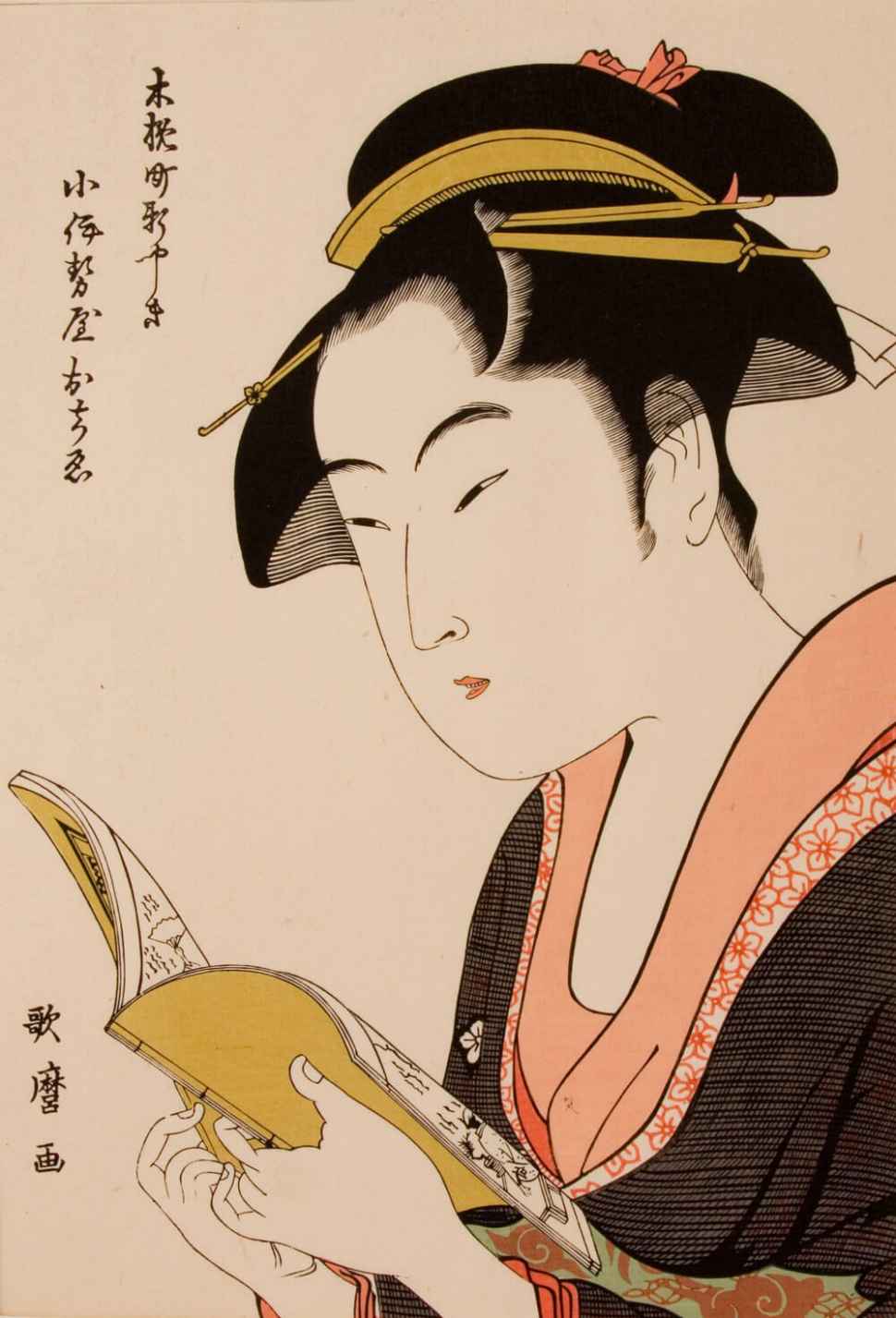
Kitagawa Utamaro
Born 1753
Died 1806
Ochie of the Ko-iseya at kobiki-cho, shun-Yashiki (Kobikicho, shin-yashiki ko-iseya Ochie) from the series Famous Beauties of Edo (Edo Komei bijin) c.1792 woodblock print, coloured inks and white mica on paper 35.5 x 24.5 cm
Gift of Miss M.E. Wharmby
Collection of Flinders University Museum of Art 447
The woman depicted in this half-length portrait is seventeen-year old Ochie – noted by the inscription in the work – who is reading a political, satirically-charged graphic novel. Ochie of the Ko-iseya at kobiki-cho, shun-Yashiki is from Utamaro’s well known series Famous Beauties of Edo (Edo Komei bijin). This series exemplifies the voyeuristic tendency of some binji-ga portraits, where female figures are unknowingly observed in private moments of contemplation.
Utamaro’s close cropping of the figure was not unique to ukiyo-e prints during the Kansei period (1789-1801) and was likely inspired by imported Ming Dynasty (1368-1644) woodblock prints from China. The female figures, known as Bijin okubi-e (Large-headed pictures of beautiful women), are printed against a reflective mica background which contrasts with their pearly white skin. The shimmering surface also makes reference to earlier Japanese byobu (screen works).
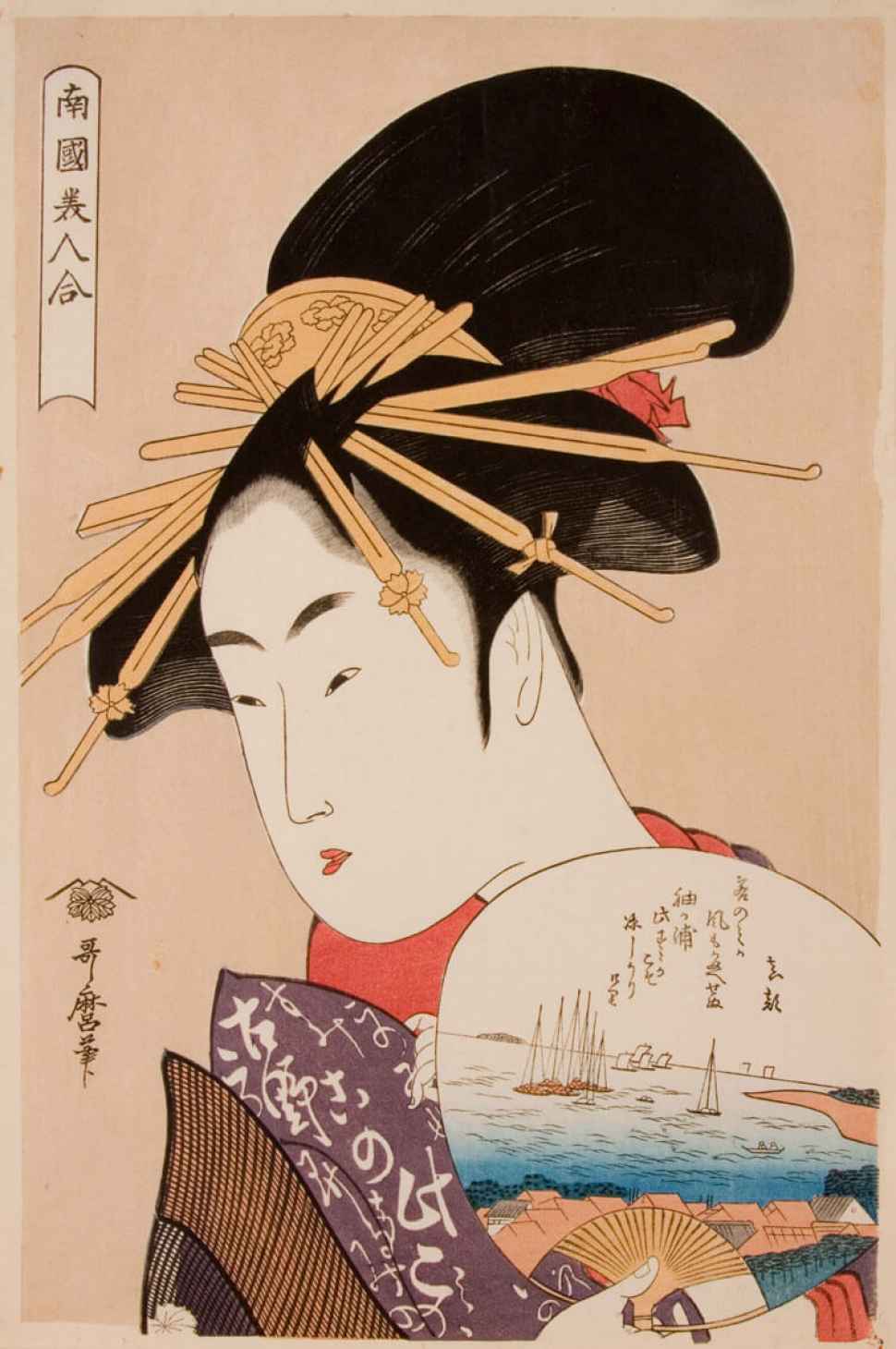
Kitagawa Utamaro
Born 1753
Died 1806
Comparison of beauties of the southern quarter (Nangoku bijin awase) c.1793 woodblock print, coloured inks and white mica on paper
37.5 x 23.5 cm
Gift of Miss M.E. Wharmby
Collection of Flinders University Museum of Art 578
The elaborate hair arrangement, ornate jewellery and fan indicated this elegant woman was a high-ranking courtesan from the Yoshiwara in Shinagawa, an unlicensed pleasure district on the southern outskirts of Edo (present-day Tokyo). The calligraphic pattern on the sitter’s robe and the text in the poem suggests her name is Konosumi.
On the fan is a kyoka poem by Magao Shikatsube entitled sode ga ura (Behind the Kimono Sleeve). The title of the poem refers to both Konosumi’s ability to entice men with a beguiling giggle using her sleeve to cover her smile and Sodegaura Bay, the name of a beach near Shinagawa which was shaped like a sleeve. The device of the fan enables Utamaro to artfully place information within the print. Viewers of the time would easily have recognized the girl and where she came from even though she is not directly named.
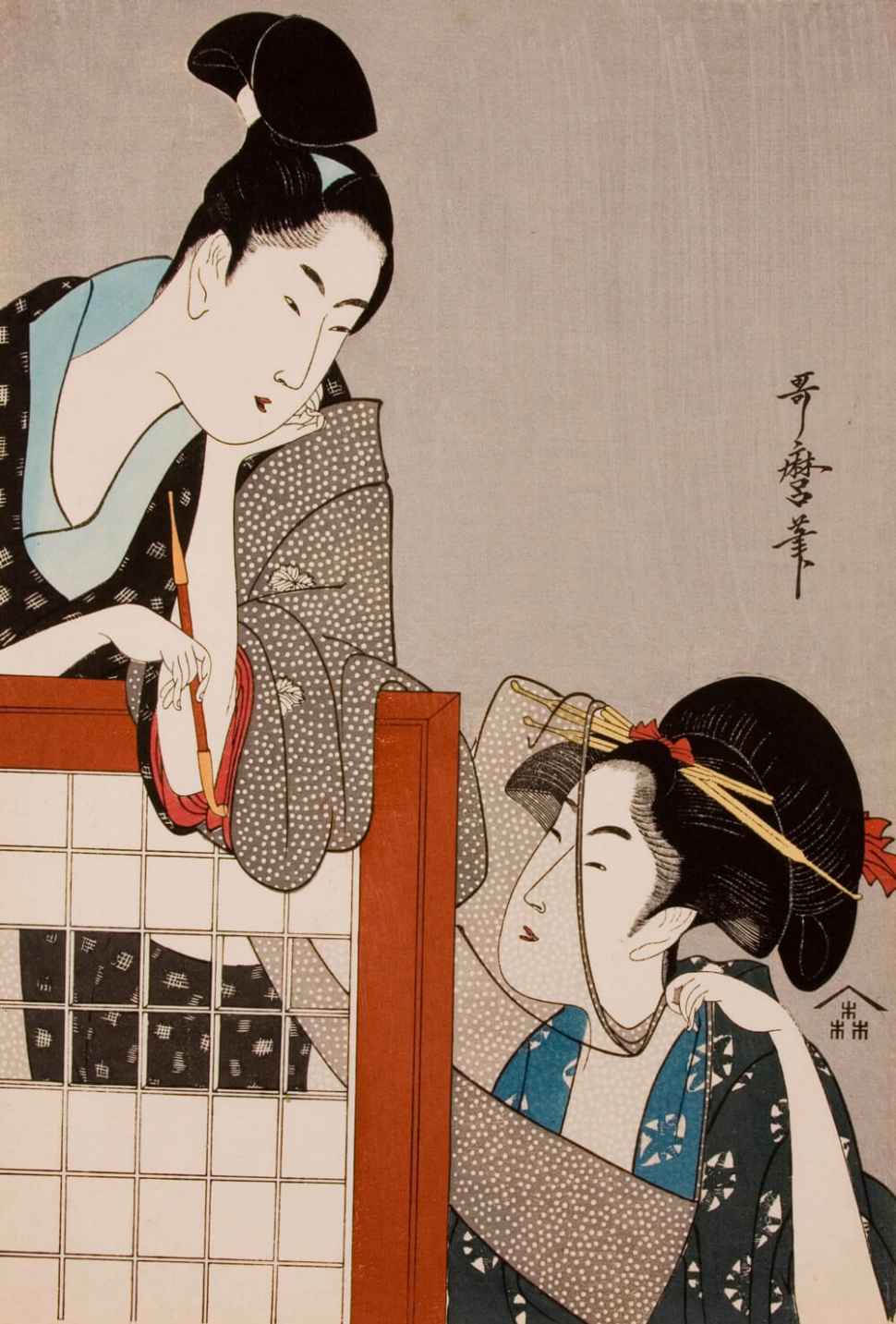
Kitagawa Utamaro
Born 1753
Died 1806
Man and woman beside a free-standing screen (Tsuitate no danjo) c.1797 woodblock print, coloured inks on paper 37.6 x 25.5 cm
Gift of Miss M.E. Wharmby
Collection of Flinders University Museum of Art 577
Utamaro’s woodblock print Man and woman beside a free-standing screen (Tsuitate no danjo) depicts a girl playfully flirting with a young man. She hides her face behind the sheer material of his jacket, which bears his mon (family crest). The young man is likely in his late teens, indicated by his hairstyle as grown men were expected to shave the pate (crown of the head). He leans over the dividing screen and smokes tobacco, which was commonly used at this time and freely provided to guests in brothels and tea houses.
Flinders University Museum of Art
Flinders University I Sturt Road I Bedford Park SA 5042
Located ground floor Social Sciences North building, Humanities Road adjacent carpark 5
Telephone | +61 (08) 8201 2695
Email | museum@flinders.edu.au
Monday to Friday | 10am - 5pm or by appointment
Thursdays | Until 7pm
Closed weekends and public holidays
FREE ENTRY
Flinders University Museum of Art is wheelchair accessible, please contact us for further information.


